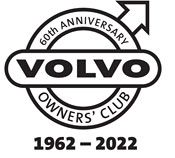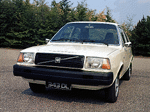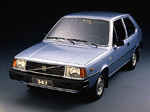



Profile on the Volvo 340 66 CVT Variomatic
By George Dickinson
What is a "CVT" and why does the VOC have a special little corner called "66/340 CVT Register"? CVT stands for Continuously Variable Transmission, which is an automatic transmission that has an infinite number of ratios between bottom and top gear. The control system automatically selects the most appropriate ratio and thus engine speed, so that engine power is applied to the road wheels in the most effective way in accordance with the driver's wishes and the prevailing gradient. The action is totally smooth, without bumps or jerks. The Volvo involvement with CVT began in the early/mid 70's when the Company assumed responsibility for car production in the "DAF" car factory at Born in Holland, and thereby inherited the "DAF 66", which then, with modifications, became the Volvo 66. The "politics" were complicated and included a Dutch Government share-holding, varying in proportion over the years before and since.
At this point it is essential to inter-leave a little more history. The Van Doorne brothers started business in 1928. Soon into trailers (Van Doorne's Aanhangwagen Fabrik - DAF), they diversified into cars in the late 1950's. (A became Automobiel). The story is long and fascinating, its central figure, Hub Van Doorne, being a brilliant innovator. The heart of the car was the CVT, called "Variomatic" All DAF cars had it. The first were of 600, then 750 cc (Daffodil, 30, 31, 32, 33), all with air-cooled, two-cylinder, four-stroke engines. They were joined by an 850 (DAF 44, 46), and later still by 1100 and 1300 cc water-cooled four-cylinder, Renault-engined models (DAF 55 and 66). The 66 line continued with the Volvo badge, but without the racy coupe model, from 1975 to 1980 for a total of about 106,000 examples, of which perhaps 12-14,000 entered the UK. An entirely new shape appeared from Born in 1976, the Volvo 343, DAF originated and very definitely CVT endowed. This was progressively developed, including the addition of manual gearbox and larger engines, until phased out in 1991. Thus the Variomatic itself was available for 32 years, the world's first practical, quantity-produced CVT.

The next question is how does the CVT work? In essence it is a rubber-belt drive shared between two pairs of pulleys. The engine drives the "primary" pulleys, the belts drive from "primary" to "secondary", and the "secondary" pulleys drive the rear wheels. Forward and reverse direction selection is achieved by dog-clutches in the primary gear box, gear-ratio changing is achieved by varying the effective diameters of the two sets of pulleys together, and the final reduction and differential are in the secondary gear box. Each pulley is made in two halves, a fixed part and a sliding part. The primary sliding part is outboard and the secondary sliding part is inboard. As the gear ratio increases (bottom half of diagram to top half), primary and secondary pulleys slide in unison and the belts move bodily forwards and inwards. Ratio control is principally by flyweights inside the primary drums, assisted or opposed by engine vacuum applied outside or inside diaphragms within the drums in accordance with the operation of an electromagnetic valve (EMV) in the engine compartment. Belt tension is maintained by powerful springs in the secondary pulleys. The final element is the automatic centrifugal clutch at the rear of the engine; this also has a vacuum-operated servo which is activated by the direction selection lever so as to raise the clutch engagement speed except when "forward" or "reverse" are fully selected.
The whole system may sound very complicated whereas, in reality, it is delightfully simple mechanically, not that much different in total from an ordinary clutch and gearbox system, and much simpler than a conventional torque-converter type automatic. If the Variomatic CVT is so good, you may ask, why did it not "catch on" in a big way? There are many reasons.
- It was innovative, and the public at large tends to be suspicious of innovations, especially when they are out-of-step with popular trends.
- he DAF Company was small and was not an obvious part of the "mainstream" motor world. It was also a late comer to the motoring market, and effective agencies were less than easy to come by.
- Prices were not particularly cheap in the world market place.
- A lot of snide remarks were made in the press, especially in the motoring press, about "elastic bands" and so on (they still are). In other words the Variomatic car was made into a bit of a joke by and to those who had never owned or driven one. It also managed to acquire the cachets of an old person's car and of a "shopping trolley"
- The way the engine ran straight up to maximum torque speed and stayed there while the car itself "caught up" became a source of puzzlement or amusement, again magnified out of proportion by antagonistic motoring writers.
- The transmission package is fairly bulky and needs suitable space under the rear of the car to accommodate it. In other words it could not be sold generally for fitting to any make or model of car, but would only fit a car specially designed for it.
- The simple maintenance adjust-ments of belts and clutch entailed getting underneath the car, a deterrent to the DIYer and usually neglected by garages. The resulting short belt life and clutch life (and failures on the road) gave the car an unjustifiably bad name for poor reliability and expensive repairs.
- Though substantial improvements to details which gave longevity and improved reliability had been made to the Variomatic over the years, those further few steps necessary to get "over the last hump" were never taken
- The reputation of automatic transmissions of the conventional type for absorbing too much engine power was incorrectly ascribed to the Variomatic.
- The unexplained and really quite illogical resistance of Europeans to automatic transmission was against Variomatic throughout its lifetime. In Volvo 340 days, when manual and automatic were available side-by-side, the Variomatic was sur-charged in price, and salesmen tended to disregard the Variomatic if they could: "well, we can get one for you if you really insist" type of attitude.
Yet, for all these "headwinds" against the Variomatic, it stayed the course with over a million made in 32 years, and it should easily pass 40 years in service. And that, one would have thought, was a success story. From my own 315,000 Variomatic miles, part of a family total of nearly 600,000 in 33, 55, 66 and 340 models, I would certainly deem the Variomatic very successful. Yes, the earlier DAF's did have mechanical problems, but the 340's are remarkably free from them, provided the simple maintenance is done. As to an ability to consume miles, 100,000 on a 340 odometer is easy and, if a few years at 20,000 or more are included, 150,000-200,000 miles is not out of the ordinary. Manual 300's are comparable to CVT in this respect. It is also to be noted that, overall, the 340 is a substantially better motor car than the 66, regardless of the 66's neater and more attractive appearance. All the Variomatic cars had a very modest power-to-weight ratio, but could (can) surprise everybody at their practical performance away from a standing start, 0-30 mph and 0-40 mph. The front line at the traffic lights is an interesting place to be. When the lights change, apply gentle pressure to the throttle pedal and you're away, while all "the rest" are still sitting there, fumbling around you might say. Who'd have a gearbox? The resilient rubber belt Variomatic has now been superseded by another brilliant Van Doorne concept, the very compact steel band-and-block pusher-belt "Transmatic". It is available in a number of makes of car, now including the Volvo 400. But the old story seems to be repeating itself. Surcharged prices. Just "an option" in the car catalogues . Derogatory remarks by "smart" motoring writers. General indifference by the motoring public. Sluggish sales. Yet if Transmatic is merely as good as Variomatic, it is far ahead of any other form of propulsion available except electric (disregarding the present limitations of batteries). One can only hope that the merits of CVT do at long last come to be appreciated.
Legal | Privacy | Contact Us | Search | Site Map
Volvo Owners' Club Limited® 1962-2024

